Glass | 2015-2016
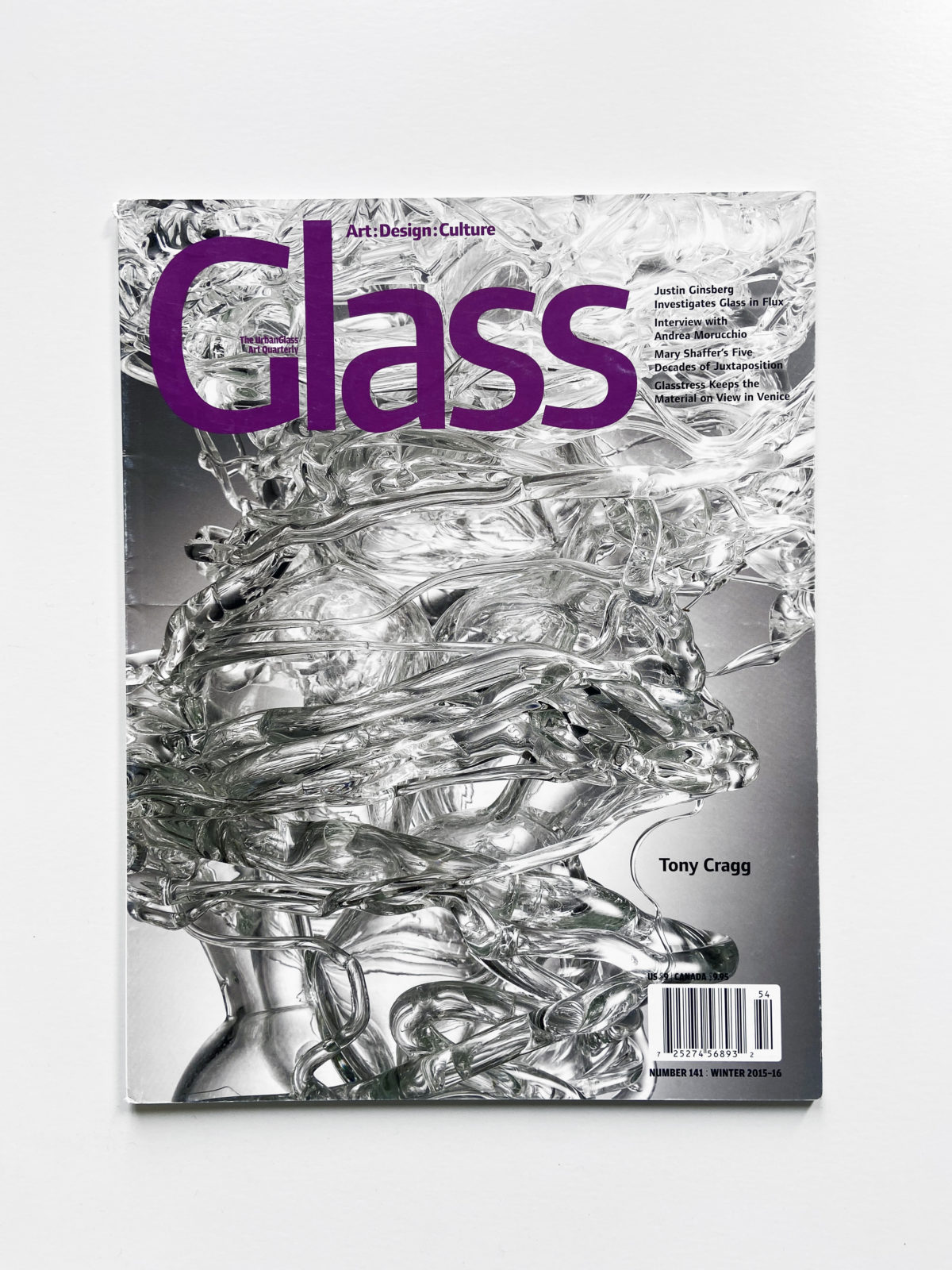
Andrea Morucchio Website

Glass as "Super Material" | Winter 2015-2016 | Andrea Morucchio interviewed by Lise Kjaer
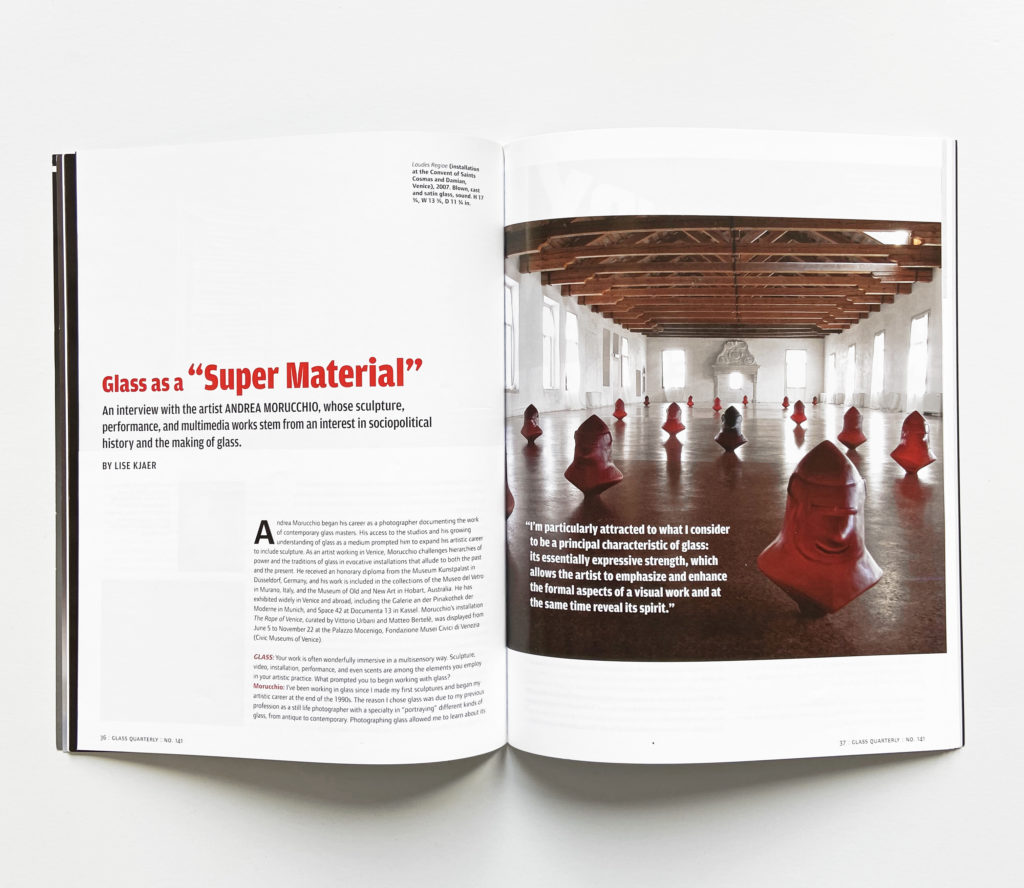
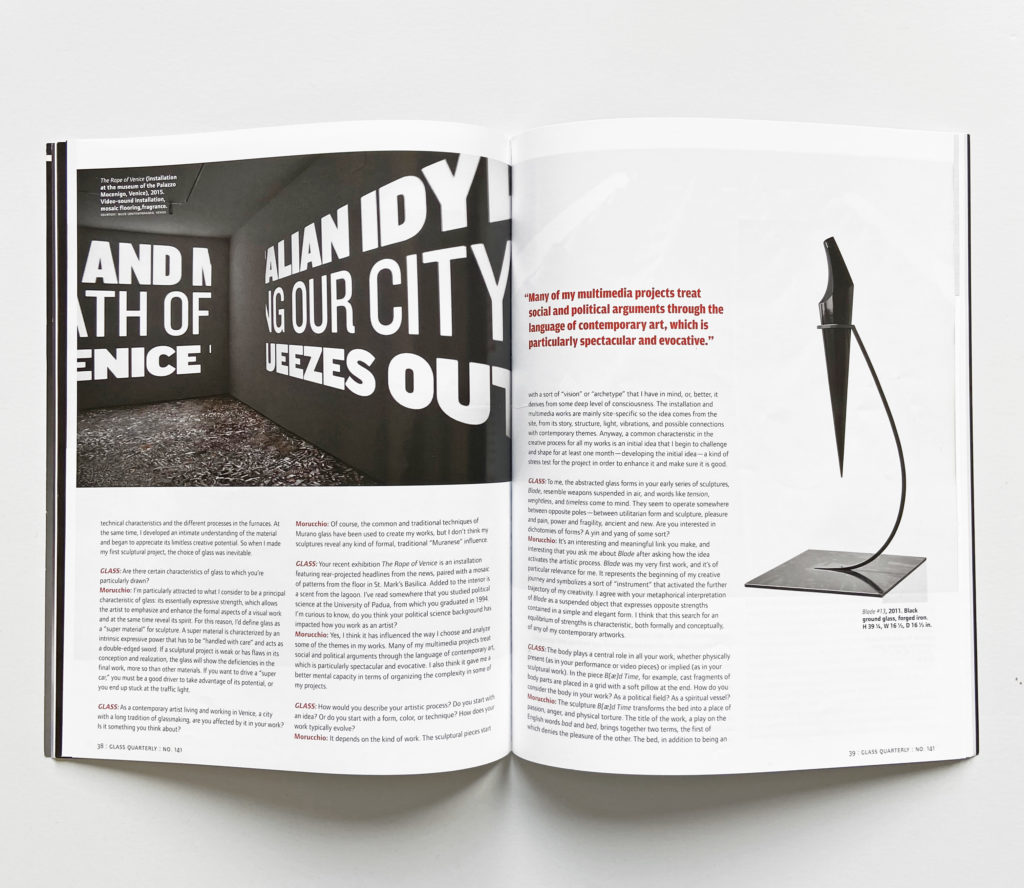
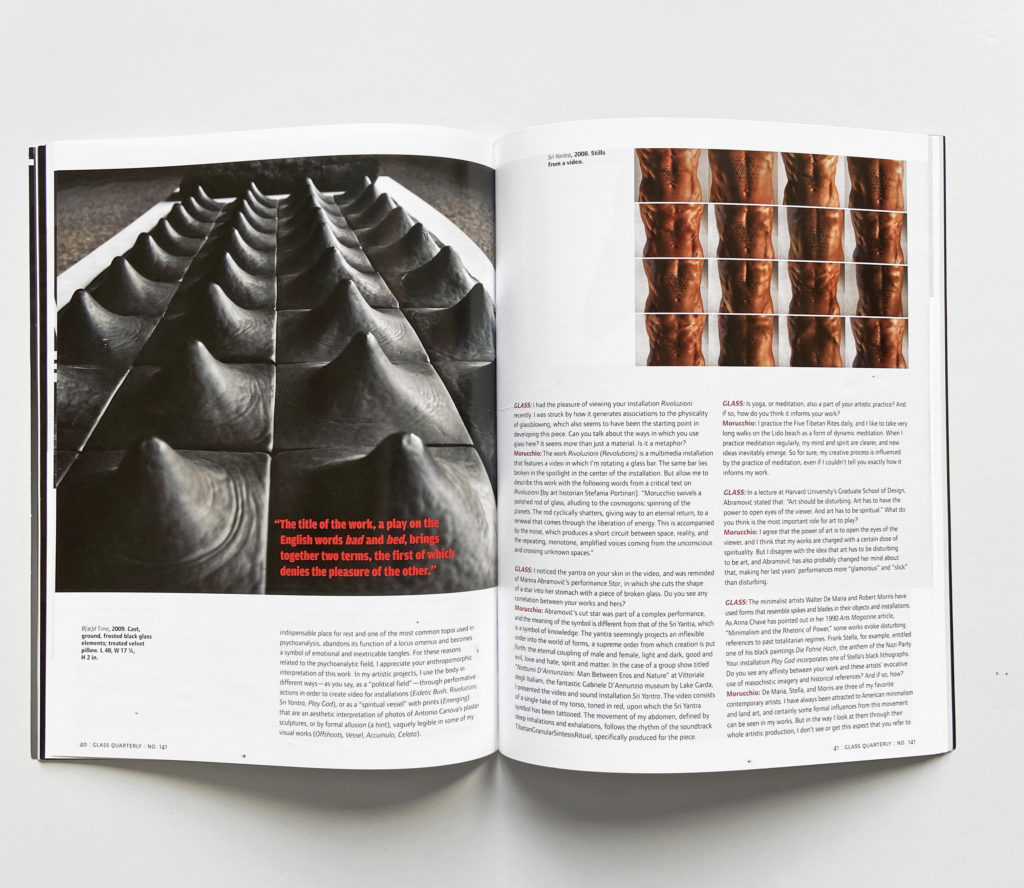
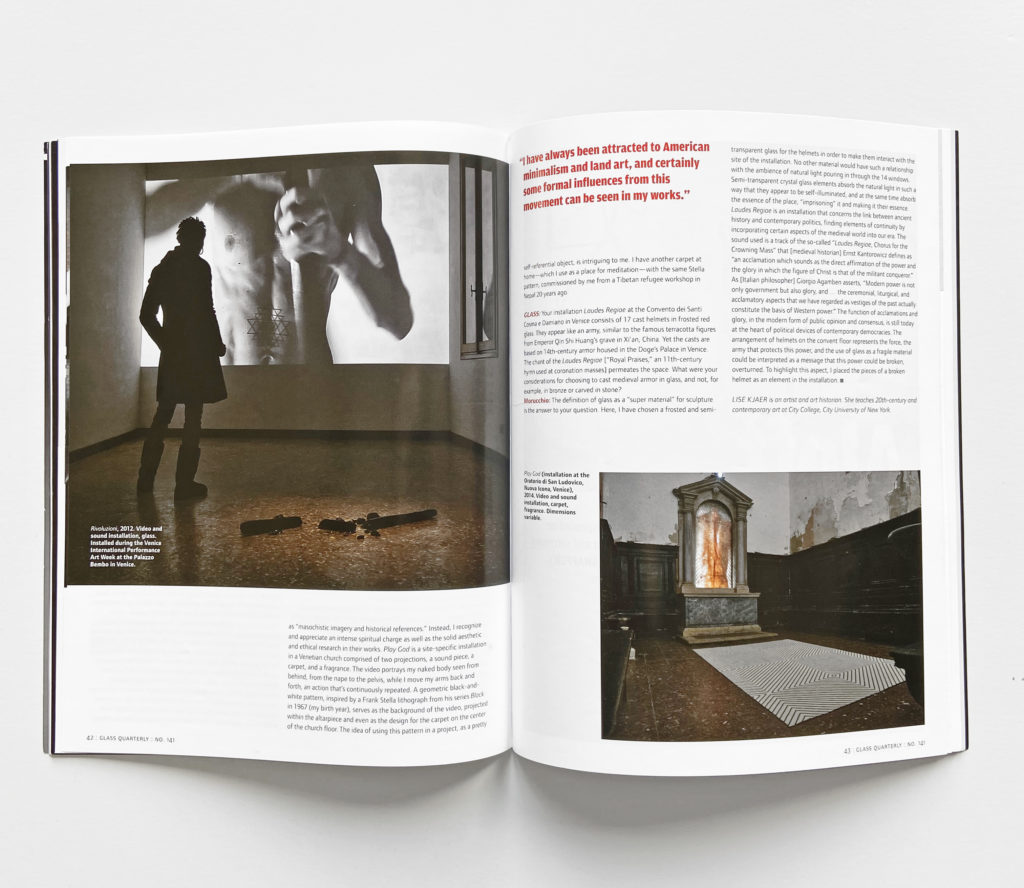
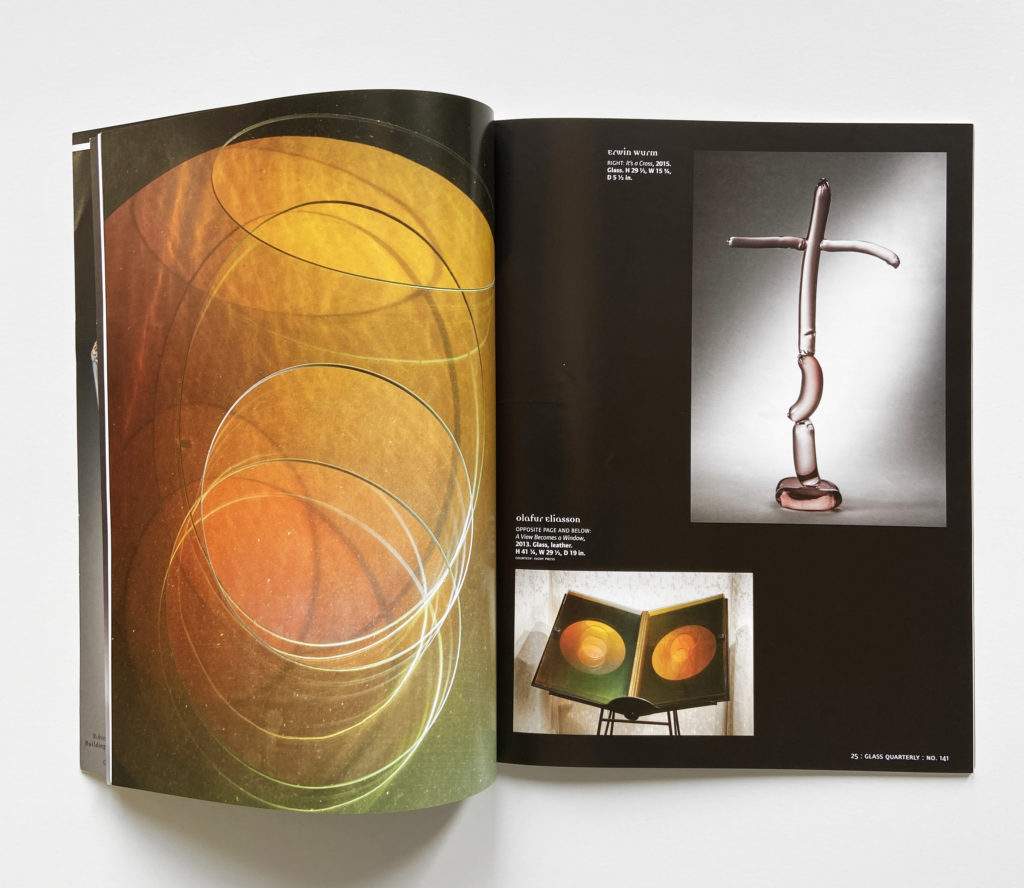
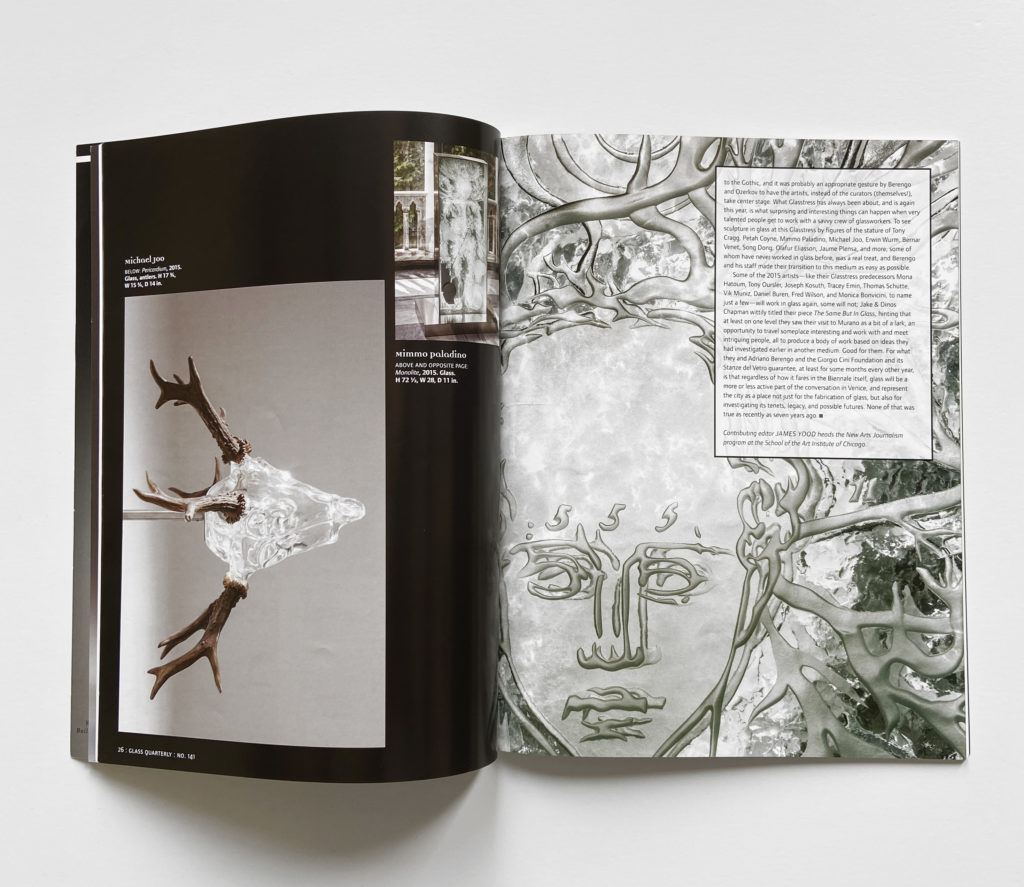
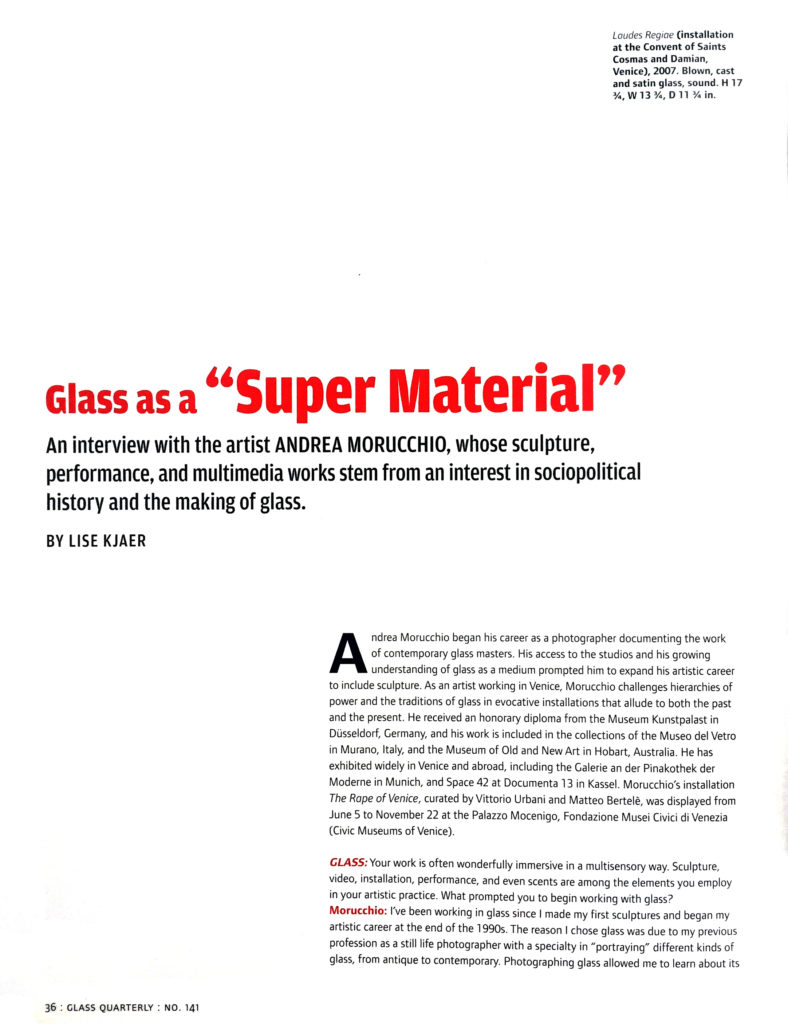
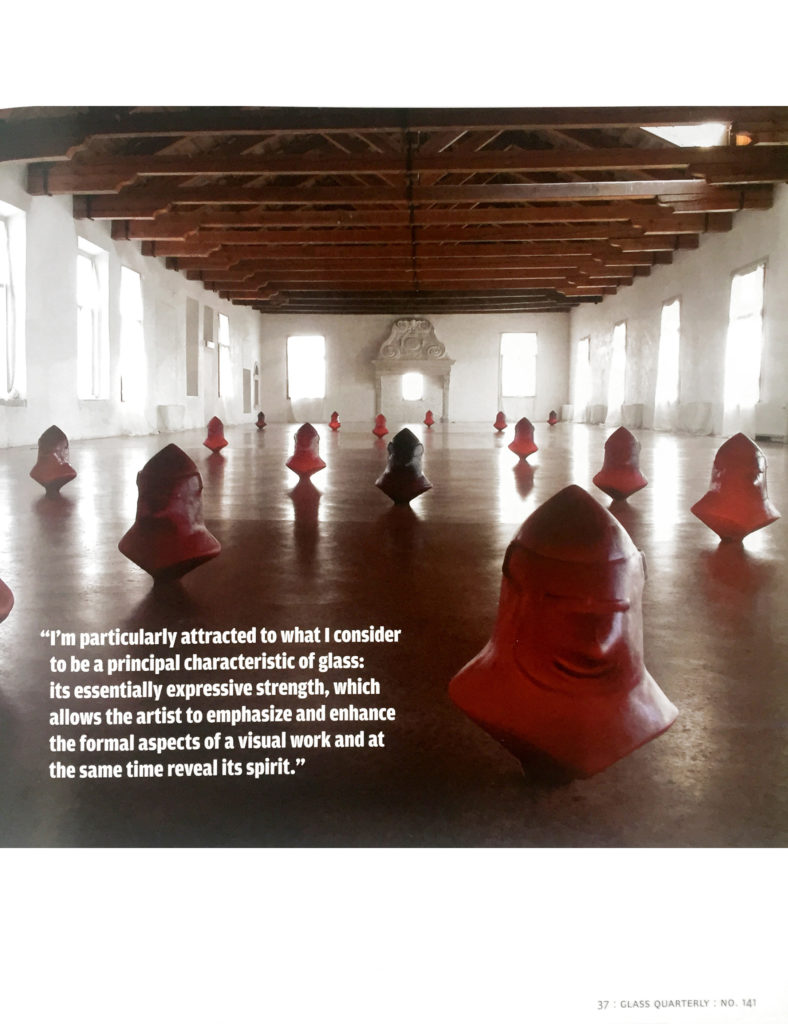
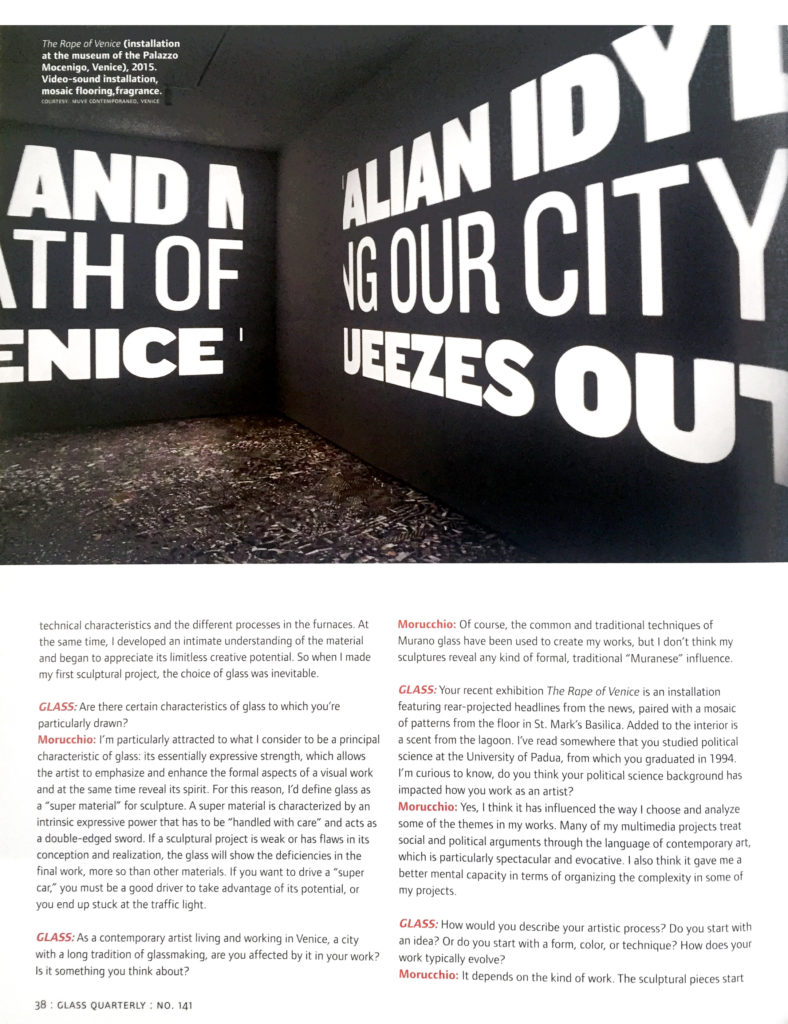
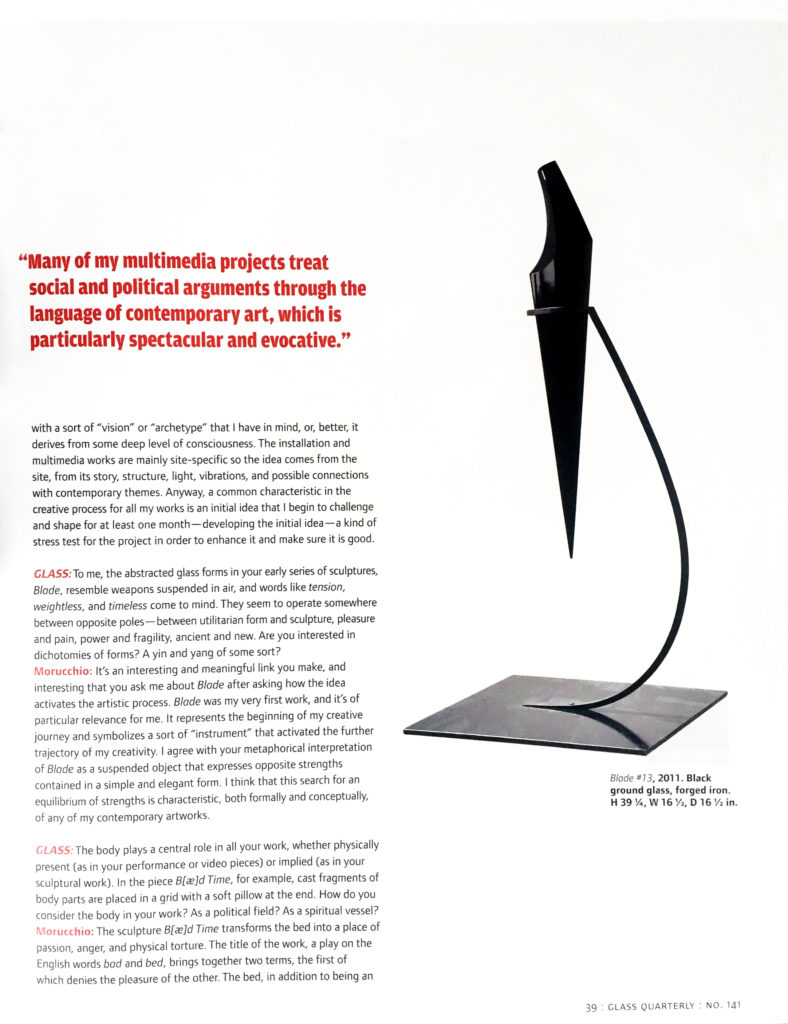
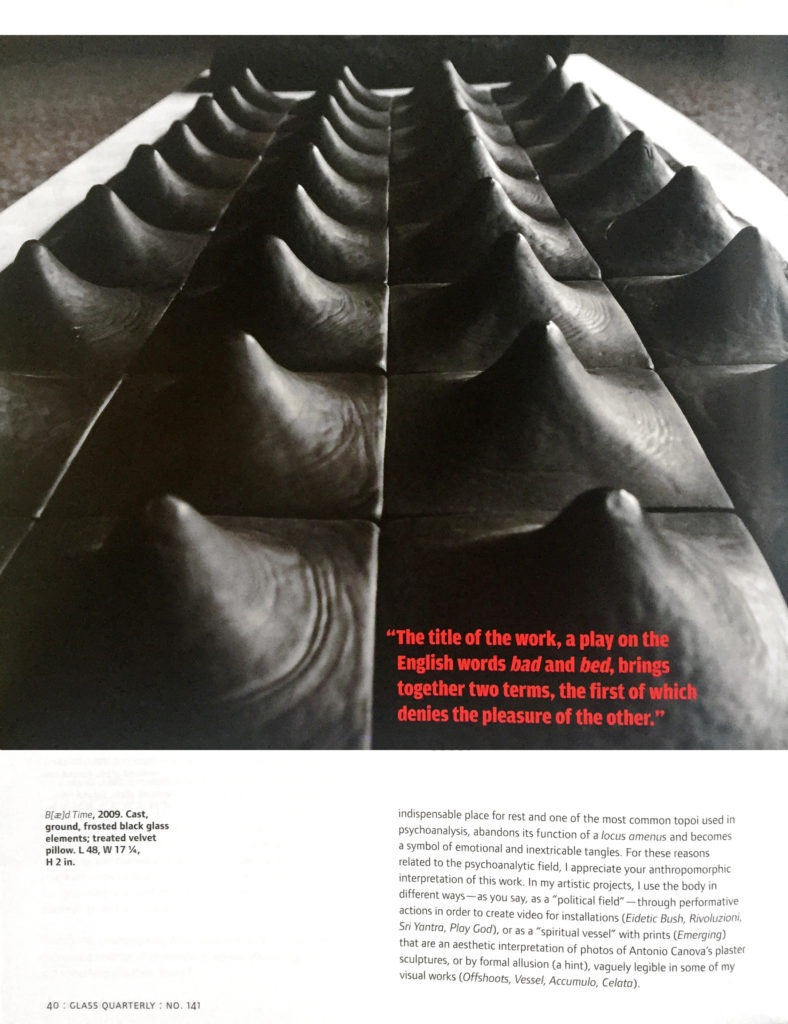
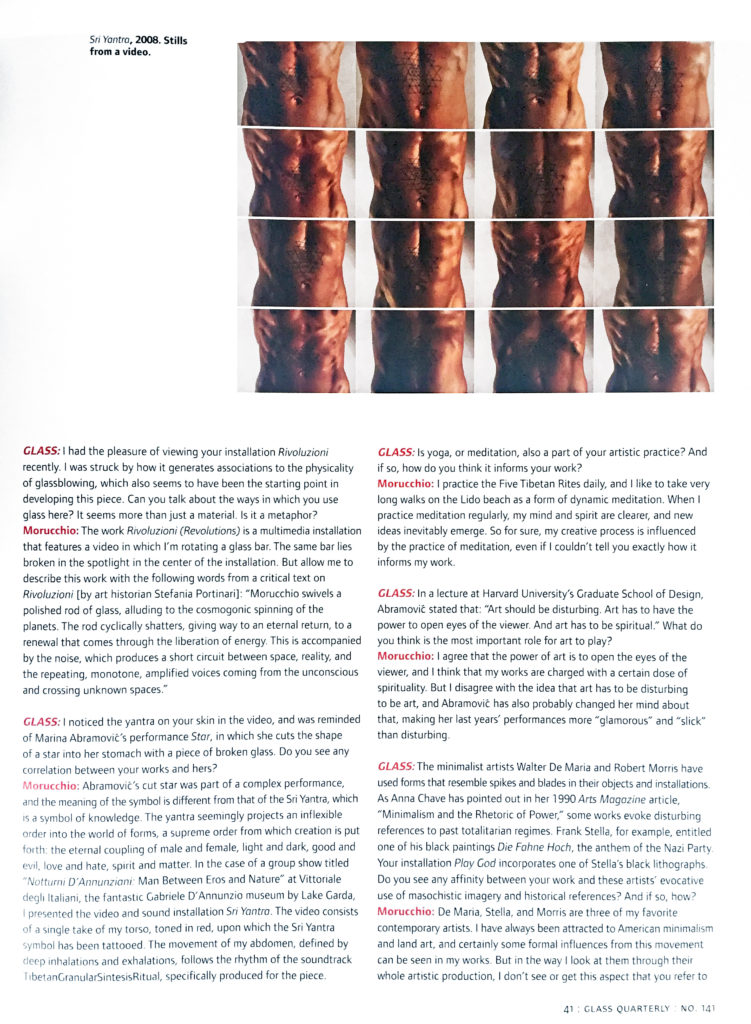
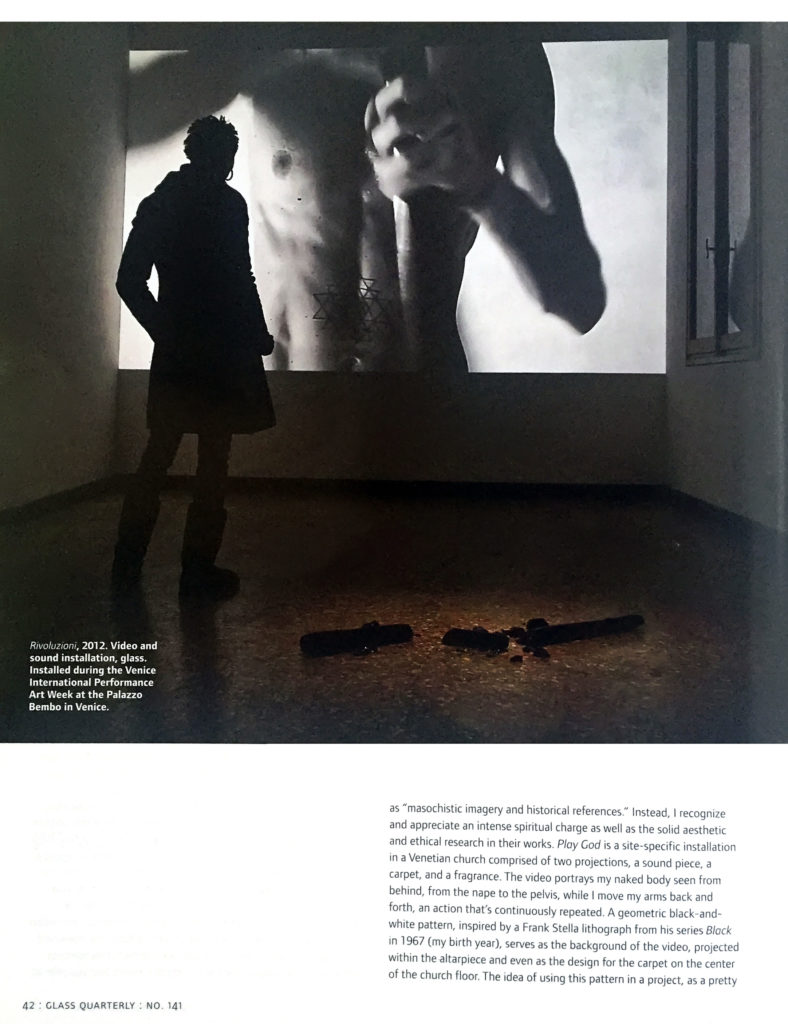
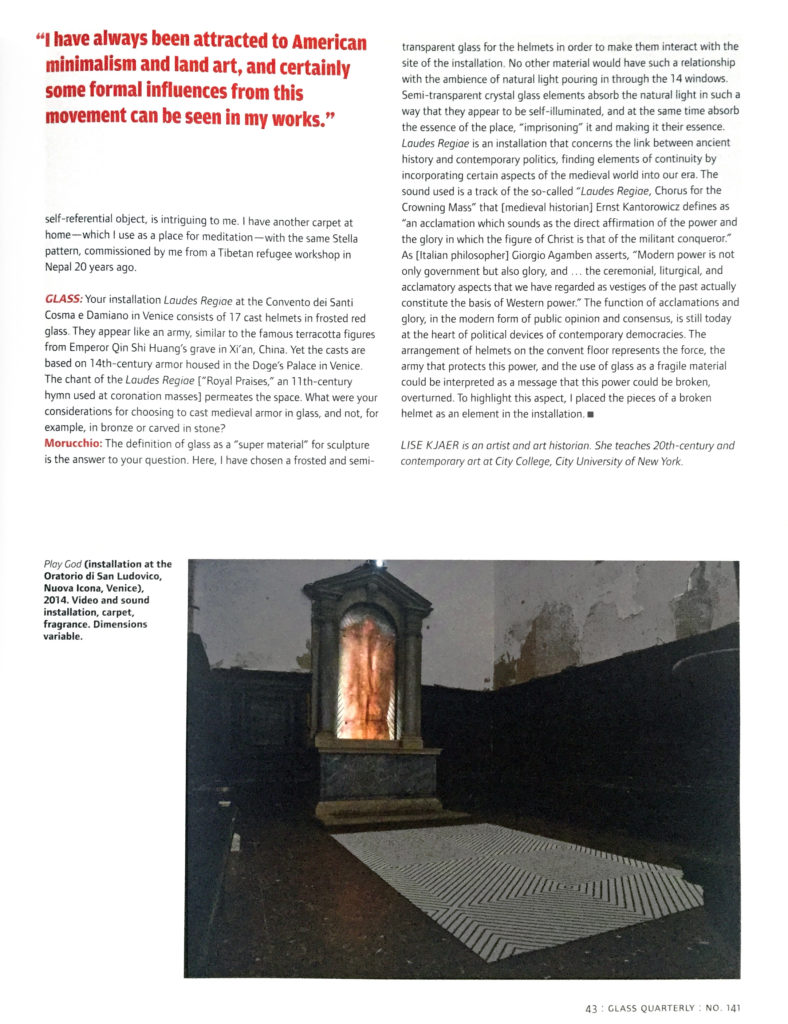
Glass as a “Super Material” by Lise Kjaer An interview with the artist Andrea Morucchio, whose sculpture, performance and multimedia works stem from an interest in socio-political history and the making of glass. Andrea Morucchio began his career as a photographer documenting the work of contemporary glass masters. His access to the studios and his growing understanding of glass as a medium prompted him to expand his artistic career to include sculpture. As an artist working in Venice, Morucchio challenges hierarchies of power and the traditions of glass in evocative installations that allude to both past and present. He received an honorary diploma from the Museum Kunstpalast in Düsseldorf, Germany, and his work is included in the collections of the Museo del Vetro in Murano, Italy, and the Museum of Old and New Art in Hobart, Australia. He has exhibited widely in Venice and abroad, including the Galerie an der Pinakothek der Moderne in Munich, and Space 42 at Documenta 13 in Kassel. Morucchio’s installation The Rape of Venice, curated by Vittorio Urbani and Matteo Bertelè, is on display until November 22 at the Palazzo Mocenigo, Fondazione Musei Civici di Venezia (Civic Museums of Venice). GLASS: Your work is often wonderfully immersive in a multisensory way. Sculpture, video, installation, performance, and even scents are among the elements you employ in your artistic practice. What prompted you to begin working with glass? Morucchio: I’ve been working in glass since I made my first sculptures and began my artistic career at the end of the 1990s. The reason I chose glass was due to my previous profession as a still life photographer with a specialty in “portraying” different kinds of glass, from antique to contemporary. Photographing glass allowed me to learn about its technical characteristics and the different processes in the furnaces. At the same time, I developed an intimate understanding of the material and began to appreciate its limitless creative potential. So when I made my first sculptural project, the choice of glass was inevitable. GLASS: Are there certain characteristics of glass to which you’re particularly drawn? Morucchio: I’m particularly attracted to what I consider to be a principal characteristic of glass: its essentially expressive strength, which allows the artist to emphasize and enhance the formal aspects of a visual work and at the same time reveal its spirit. For this reason, I’d define glass as a “super material” for sculpture. A super material is characterized by an intrinsic expressive power that has to be “handled with care” and acts as a double-edged sword. If a sculptural project is weak or has flaws in its conception and realization, the glass will show the deficiencies in the final work, more so than other materials. If you want to drive a “super car,” you must be a good driver to take advantage of its potential, or you end up stuck at the traffic light. GLASS: As a contemporary artist living and working in Venice, a city with a long tradition of glassmaking, are you affected by it in your work? Is it something you think about? Morucchio: Of course, the common and traditional techniques of Murano glass have been used to create my works, but I don’t think my sculptures reveal any kind of formal, traditional “Muranese” influence. GLASS: Your recent exhibition The Rape of Venice is an installation featuring rear-projected headlines from the news, paired with a mosaic of patterns from the floor in St. Mark’s Basilica. Added to the interior is a scent from the lagoon. I’ve read somewhere that you studied political science at the University of Padua, from which you graduated in 1994. I’m curious to know, do you think your political science background has impacted how you work as an artist? Morucchio: Yes, I think it has influenced the way I choose and analyze some of the themes in my works. Many of my multimedia projects treat social and political arguments through the language of contemporary art, which is particularly spectacular and evocative. I also think it gave me a better mental capacity in terms of organizing the complexity in some of my projects. GLASS: How would you describe your artistic process? Do you start with an idea? Or do you start with a form, color, or technique? How does your work typically evolve? Morucchio: It depends on the kind of work. The sculptural pieces start with a sort of “vision” or “archetype” that I have in mind, or, better, it derives from some deep level of consciousness. The installation and multimedia works are mainly site-specific, so the idea comes from the site, from its story, structure, light, vibrations, and possible connections with contemporary themes. Anyway, a common characteristic in the creative process for all my works is an initial idea that I begin to challenge and shape for at least one month—developing the initial idea—a kind of stress test for the project in order to enhance it and make sure it is good. GLASS: To me, the abstracted glass forms in your early series of sculptures, Blade, resemble weapons suspended in air, and words like tension, weightless, and timeless come to mind. They seem to operate somewhere between opposite poles—between utilitarian form and sculpture, pleasure and pain, power and fragility, ancient and new. Are you interested in dichotomies of forms? A yin and yang of some sort? Morucchio: It’s an interesting and meaningful link you make, and interesting that you ask me about Blade after asking how the idea activates the artistic process. Blade was my very first work, and it’s of particular relevance for me. It represents the beginning of my creative journey, and symbolizes a sort of “instrument” that activated the further trajectory of my creativity. I agree with your metaphorical interpretation of Blade as a suspended object that expresses opposite strengths contained in a simple and elegant form. I think that this search for an equilibrium of strengths is characteristic, both formally and conceptually, of any of my contemporary artworks. GLASS: The body plays a central role in all your work, whether physically present (as in your performance or video pieces) or implied (as in your sculptural work). In the piece B[æ]d Time, for example, cast fragments of body parts are placed in a grid with a soft pillow at the end. How do you consider the body in your work? As a political field? As a spiritual vessel? Morucchio: The sculpture B[æ]d Time transforms the bed into a place of passion, anger, and physical torture. The title of the work, a play on the English words bad and bed, brings together two terms, the first of which denies the pleasure of the other. The bed, in addition to being an indispensable place for rest and one of the most common topoi used in psychoanalysis, abandons its function of a locus amenus and becomes a symbol of emotional and inextricable tangles. For these reasons, related to the psychoanalytic field, I appreciate your anthropomorphic interpretation of this work. In my artistic projects, I use the body in different ways—as you say, as a “political field”—through performative actions in order to create video for installations (Eidetic Bush, Rivoluzioni, Sri Yantra, Play God) or as a “spiritual vessel” with prints (Emerging) that are an aesthetic interpretation of photos of Antonio Canova’s plaster sculptures, or by formal allusion (a hint), vaguely legible in some of my visual works (Offshoots, Vessel, Accumulo, Celata). GLASS: I had the pleasure of viewing your installation Rivoluzioni recently. I was struck by how it generates associations to the physicality of glassblowing, which also seems to have been the starting point in developing this piece. Can you talk about the ways in which you use glass here? It seems more than just a material. Is it a metaphor? Morucchio: The work Rivoluzioni (Revolutions) is a multimedia installation that features a video in which I’m rotating a glass bar. The same bar lies broken in the spotlight in the center of the installation. But allow me to describe this work with the following words from a critical text on Rivoluzioni [by art historian Stefania Portinari]: “Morucchio swivels a polished rod of glass alluding to the cosmogonic spinning of the planets. The rod cyclically shatters, giving way to an eternal return, to a renewal that comes through the liberation of energy. This is accompanied by the noise which produces a short circuit between space, reality, and the repeating, monotone, amplified voices coming from the unconscious and crossing unknown spaces.” GLASS: I noticed the yantra on your skin in the video, and was reminded of Marina Abramović’s performance Star, in which she cuts the shape of a star into her stomach with a piece of broken glass. Do you see any correlation between your works and hers? Morucchio: Abramović’s cut star was part of a complex performance, and the meaning of the symbol is different from that of the Sri Yantra, which is a symbol of knowledge. The yantra seemingly projects an inflexible order into the world of forms, a supreme order from which creation is put forth: the eternal coupling of male and female, light and dark, good and evil, love and hate, spirit and matter. In the case of a group show titled “Notturni D’Annunziani: Man Between Eros and Nature” at Vittoriale degli Italiani, the fantastic Gabriele D’Annunzio museum by Lake Garda, I presented the video and sound installation Sri Yantra. The video consists of a single take of my torso, toned in red, upon which the Sri Yantra symbol has been tattooed. The movement of my abdomen, defined by deep inhalations and exhalations, follows the rhythm of the soundtrack TibetanGranularSintesisRitual, specifically produced for the piece. GLASS: Is yoga, or meditation, also a part of your artistic practice? And if so, how do you think it informs your work? Morucchio: I practice the Five Tibetan Rites daily, and I like to take very long walks on the Lido beach as a form of dynamic meditation. When I practice meditation regularly, my mind and spirit are clearer, and new ideas inevitably emerge. So, for sure, my creative process is influenced by the practice of meditation, even if I couldn’t tell you exactly how it informs my work. GLASS: In a lecture at Harvard University’s Graduate School of Design, Abramović stated that: “Art should be disturbing. Art has to have the power to open eyes of the viewer. And art has to be spiritual.” What do you think is the most important role for art to play? Morucchio: I agree that the power of art is to open the eyes of the viewer, and I think that my works are charged with a certain dose of spirituality. But I disagree with the idea that art has to be disturbing to be art, and Abramović has also probably changed her mind about that, making her last years’ performances more “glamorous” and “slick” than disturbing. GLASS: The minimalist artists Walter De Maria and Robert Morris have used forms that resemble spikes and blades in their objects and installations. As Anna Chave has pointed out in her 1990 Arts Magazine article, “Minimalism and the Rhetoric of Power,” some works evoke disturbing references to past totalitarian regimes. Frank Stella, for example, entitled one of his black paintings Die Fahne Hoch, the anthem of the Nazi Party. Your installation Play God incorporates one of Stella’s black lithographs. Do you see any affinity between your work and these artists’ evocative use of masochistic imagery and historical references? And if so, how? Morucchio: De Maria, Stella, and Morris are three of my favorite contemporary artists. I have always been attracted to American minimalism and land art, and certainly some formal influences from this movement can be seen in my works. But in the way I look at them through their whole artistic production, I don’t see or get this aspect that you refer to as “masochistic imagery and historical references.” Instead, I recognize and appreciate an intense spiritual charge as well as the solid aesthetic and ethical research in their works. Play God is a site-specific installation in a Venetian church comprised of two projections, a sound piece, a carpet, and a fragrance. The video portrays my naked body seen from behind, from the nape to the pelvis, while I move my arms back and forth, an action that’s continuously repeated. A geometric black-and-white pattern, inspired by a Frank Stella lithograph from his series Black in 1967 (my birth year), serves as the background of the video, projected within the altarpiece and even the design for the carpet on the center of the church floor. The idea of using this pattern in a project, as a pretty self-referential object, is intriguing to me. I have another carpet at home—which I use as a place for meditation—with the same Stella pattern, commissioned by me from a Tibetan refugee workshop in Nepal 20 years ago. GLASS: Your installation Laudes Regiae at the Convento dei Santi Cosma e Damiano in Venice consists of 17 cast helmets in frosted red glass. They appear like an army, similar to the famous terracotta figures from Emperor Qin Shi Huang’s grave in Xi’an, China. Yet the casts are based on 14th-century armor housed in the Doge’s Palace in Venice. The chant of the Laudes Regiae [“Royal Praises,” an 11th-century hymn used at coronation masses] permeates the space. What were your considerations for choosing to cast medieval armor in glass, and not, for example, in bronze or carved in stone? Morucchio: The definition of glass as a “super material” for sculpture is the answer to your question. Here, I have chosen a frosted and semitransparent glass for the helmets in order to make them interact with the site of the installation. No other material would have such a relationship with the ambience of natural light pouring in through the 14 windows. Semi-transparent crystal glass elements absorb the natural light in such a way that they appear to be self-illuminated, and at the same time absorb the essence of the place, “imprisoning” it and making it their essence. Laudes Regiae is an installation that concerns the link between ancient history and contemporary politics, finding elements of continuity by incorporating certain aspects of the medieval world into our era. The sound used is a track of the so-called “Laudes Regiae, Chorus for the Crowning Mass” that [medieval historian] Ernst Kantorowicz defines as “an acclamation, which sounds as the direct affirmation of the power and the glory in which the figure of Christ is that of the militant conqueror.” As [Italian philosopher] Giorgio Agamben asserts, “Modern power is not only government but also glory, and … the ceremonial, liturgical, and acclamatory aspects that we have regarded as vestiges of the past actually constitute the basis of Western power.” The function of acclamations and glory, in the modern form of public opinion and consensus, is still today at the heart of political devices of contemporary democracies. The arrangement of helmets on the convent floor represents the force, the army that protects this power, and the use of glass as a fragile material could be interpreted as a message that this power could be broken, overturned. To highlight this aspect, I placed the pieces of a broken helmet as an element in the installation.
Lise Kjaer is an artist and art historian. She teaches 20th-century and contemporary art at City College, City University of New York.
COPYRIGHT ©2015 GLASS: The UrbanGlass Art Quarterly (www.glassquarterly.com). All rights reserved. This article originally appeared in the Winter 2015 edition of GLASS (#141). Permission to reprint, republish and/or distribute this material in whole or in part for any other purposes must be obtained from UrbanGlass (www.urbanglass.org).